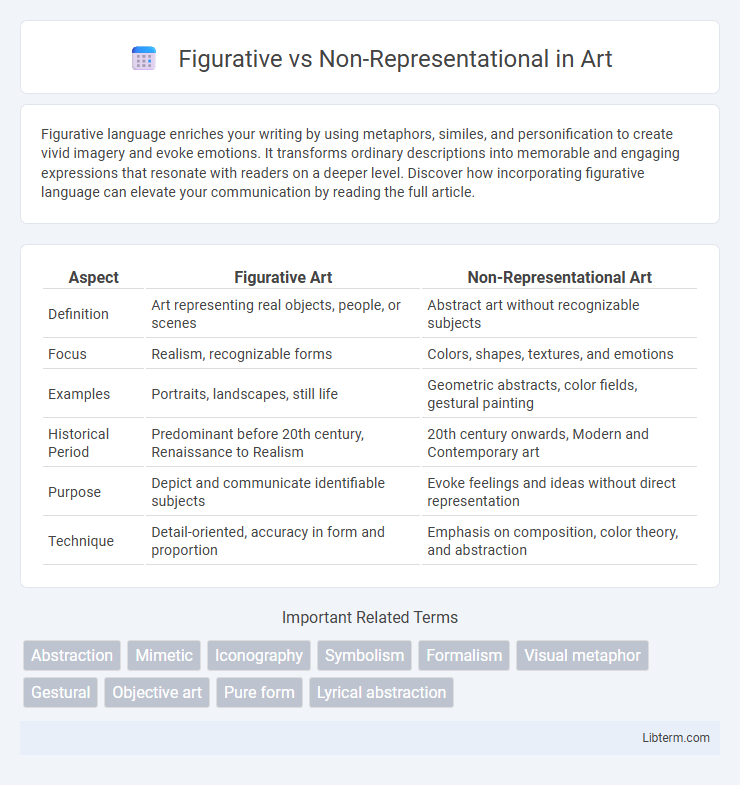Figurative language enriches your writing by using metaphors, similes, and personification to create vivid imagery and evoke emotions. It transforms ordinary descriptions into memorable and engaging expressions that resonate with readers on a deeper level. Discover how incorporating figurative language can elevate your communication by reading the full article.
Table of Comparison
| Aspect | Figurative Art | Non-Representational Art |
|---|---|---|
| Definition | Art representing real objects, people, or scenes | Abstract art without recognizable subjects |
| Focus | Realism, recognizable forms | Colors, shapes, textures, and emotions |
| Examples | Portraits, landscapes, still life | Geometric abstracts, color fields, gestural painting |
| Historical Period | Predominant before 20th century, Renaissance to Realism | 20th century onwards, Modern and Contemporary art |
| Purpose | Depict and communicate identifiable subjects | Evoke feelings and ideas without direct representation |
| Technique | Detail-oriented, accuracy in form and proportion | Emphasis on composition, color theory, and abstraction |
Understanding Figurative Art
Figurative art depicts recognizable objects or scenes from the real world, focusing on human figures, animals, and landscapes to convey clear narratives or emotions. This art form relies on realistic or stylized representation, allowing viewers to connect through familiar imagery and stories. Understanding figurative art involves analyzing how artists interpret and manipulate reality to evoke meaning, symbolism, or social commentary.
Defining Non-Representational Art
Non-representational art, also known as abstract art, emphasizes elements such as color, form, line, and texture without depicting recognizable objects or figures. It prioritizes emotional expression and visual experience over literal representation, distinguishing it from figurative art that portrays subjects from the real world. Key artists in non-representational art include Wassily Kandinsky and Kazimir Malevich, who explored pure abstraction to evoke meaning beyond visual reality.
Key Differences Between Figurative and Non-Representational
Figurative art depicts recognizable objects or scenes from the real world, emphasizing form, detail, and narrative clarity to convey specific subjects. Non-representational art, often labeled abstract, prioritizes elements such as color, shape, and texture without referencing identifiable objects, focusing on expression and interpretation. These key differences hinge on representation; figurative art anchors itself in reality, while non-representational art invites open-ended emotional or conceptual responses.
Historical Evolution of Figurative Art
Figurative art, dating back to prehistoric cave paintings such as those in Lascaux, has evolved through ancient Egyptian, Greek, and Renaissance periods emphasizing human and natural forms to convey stories and cultural values. Throughout the centuries, figurative art adapted to changing tastes and techniques, reflecting societal shifts and advancing perspectives on realism and symbolism. In contrast, non-representational art emerged in the early 20th century, prioritizing abstraction and the expression of emotions without direct reference to physical reality.
Origins and Development of Non-Representational Art
Non-representational art originated in the early 20th century as artists like Wassily Kandinsky and Kazimir Malevich sought to break away from figurative depictions, emphasizing pure abstraction and emotional expression through color and form. This movement developed alongside modernist philosophies, rejecting traditional narrative and mimetic representation in favor of exploring visual elements independently. The evolution of non-representational art was influenced by advancements in psychology, music, and spirituality, marking a radical shift in artistic intentions and methods.
Iconic Examples of Figurative Art
Iconic examples of figurative art include Leonardo da Vinci's "Mona Lisa," which showcases realistic human portraits capturing intricate emotions and anatomical precision. Michelangelo's "David" epitomizes the human form with idealized proportions, emphasizing lifelike representation and narrative storytelling. These works contrast with non-representational art by their clear depiction of recognizable subjects, embodying the essence of figurative tradition.
Notable Non-Representational Artists and Works
Notable non-representational artists include Jackson Pollock, known for his drip paintings like "No. 5, 1948," which emphasize spontaneous, abstract expression devoid of recognizable subjects. Wassily Kandinsky, often credited as a pioneer of abstract art, created works such as "Composition VII" that focus on color and form to evoke emotion without depicting real-world objects. Mark Rothko's color field paintings, exemplified by "No. 61 (Rust and Blue)," utilize large expanses of color to create a meditative, non-figurative experience emphasizing pure abstraction.
Techniques in Figurative versus Non-Representational Art
Figurative art employs techniques such as realistic shading, perspective, and anatomical accuracy to depict recognizable subjects, enhancing narrative clarity and emotional connection. Non-representational art relies on techniques like abstract forms, color fields, and textured brushwork to evoke mood and conceptual ideas without direct visual references. The deliberate use of light, line, and composition differs significantly between the two, with figurative art emphasizing representational precision and non-representational art exploring sensory and interpretive experiences.
Audience Interpretation and Emotional Impact
Figurative art employs recognizable imagery that allows audiences to connect through familiar symbols, facilitating direct emotional responses based on shared cultural references. Non-representational art, by contrast, relies on abstract forms and colors, encouraging viewers to derive personal interpretations and evoke unique emotional reactions. Audience interpretation in figurative art tends to be guided by explicit content, while non-representational works invite subjective meaning-making that emphasizes emotional impact over narrative clarity.
The Ongoing Debate: Which Resonates Today?
Figurative art, rooted in representing recognizable subjects, continues to evoke emotional connections by reflecting human experiences and narratives; non-representational art, emphasizing form, color, and texture, challenges perceptions and invites personal interpretation. Contemporary discourse examines how figurative work sustains cultural storytelling while non-representational art pushes boundaries of abstraction and conceptualism. This ongoing debate centers on the resonance of visual language in modern art, balancing tradition with innovation.
Figurative Infographic

 libterm.com
libterm.com